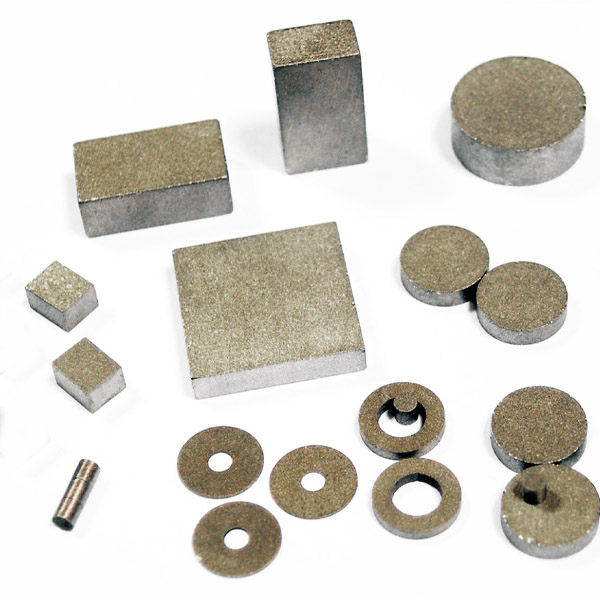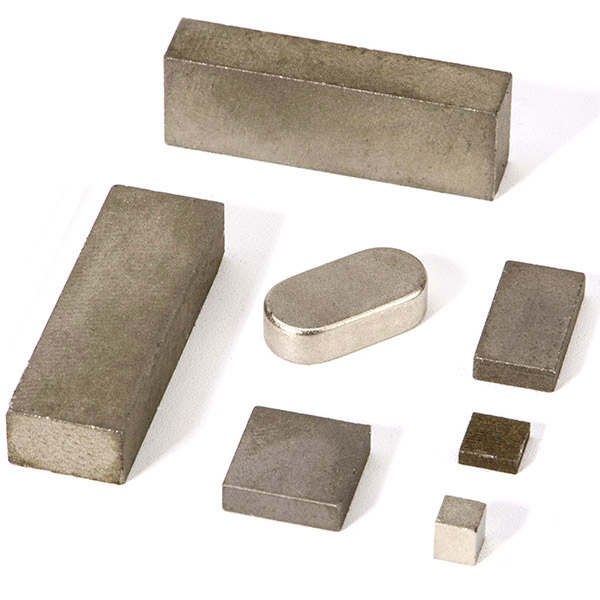What are the samarium cobalt permanent magnets?
publish_time:July 29, 2024, 4:16 p.m.Samarium cobalt permanent magnets are mainly composed of metal samarium (Sm), metal cobalt (Co), copper (Cu), iron (Fe), zirconium (Zr) and other elements. They are divided into 1:5 type and 2:17 type in terms of structure, and belong to the first and second generation rare earth permanent magnet materials. Samarium cobalt permanent magnets have excellent magnetic properties (high remanence, high coercivity and high magnetic energy product), extremely low temperature coefficient, high operating temperature and strong corrosion resistance. They are currently the best temperature-resistant permanent magnet materials and are widely used in microwave devices, electron beam devices, high power/high speed motors, sensors, magnetic components and other industries.
Production process of sintered samarium cobalt: 1. smelting, 2. powder making, 3. pressing, 4. sintering, 5. machining, 6. magnetizing & packaging
2 to 17 SmCo
2:17 SmCo magnets are also called Sm2Co17. The maximum magnetic energy product of each grade ranges from 20-35MGOe, and the maximum operating temperature is 500℃. 2:17 SmCo magnets have a lower temperature coefficient and better corrosion resistance. At high temperatures, their magnetic properties exceed those of NdFeB magnets, so they are widely used in aerospace, military, high-temperature motors, automotive sensors, various magnetic transmissions, magnetic pumps, and microwave devices. 2:17 SmCo magnets are extremely brittle and difficult to process into complex shapes or particularly thin sheets and thin-walled rings. In addition, small corners are easily missing during the production process. Generally, as long as they do not affect the magnetic properties or functions, they can be considered qualified products.
In terms of performance characteristics, SmCo permanent magnets can be divided into three types: high-performance series, high-stability series (low temperature coefficient), and high-temperature resistant series.
1 to 5 SmCo
1:5 SmCo magnets are also called SmCo 5 and SmCo5. The maximum energy product of each grade ranges from 16 to 25 MGOe, and the maximum operating temperature is 250°C. The maximum energy product is lower than that of 2:17 SmCo, but the mechanical properties and ductility are slightly better than those of 2:17. It is suitable for processing into shapes that are not easy to process with 2:17 SmCo, such as thin discs, squares, rings and various complex shapes with particularly thin thickness or walls.
The magnetizing magnetic field of 1:5 SmCo magnets is smaller than that of 2:17 SmCo. Generally, 40,000 Gauss magnetic field can be magnetized to saturation, while the magnetizing magnetic field of 2:17 high coercive force SmCo magnets requires 60,000 Gauss or higher. The rare earth content in the formula of 1:5 SmCo magnets is nearly 40%, so the price is higher than that of 2:17 SmCo magnets.
Differences between SmCo magnet and NdFeB magnet
1. Different composition
NdFeB permanent magnets contain about 29%~32.5% rare earth metal neodymium, 64%~69% metal iron, 1.1%~1.2% non-metallic element boron, and a small amount of dysprosium, terbium, niobium, copper and other elements.
For SmCo magnets, taking the 2:17 type as an example, the rare earth metal samarium accounts for 23%~28%, the rare earth metal cobalt accounts for 48%~52%, the metal element iron accounts for 14%~17%, and there are also a small amount of copper, zirconium and other elements.
2. Different performance and price
From the previous performance table, it can be found that the overall magnetic properties of SmCo permanent magnets are lower than those of NdFeB permanent magnets. From the ratio of metal elements between the two, it can be seen that the iron content in NdFeB is the highest, while the content of samarium and cobalt in SmCo magnets accounts for about 70%. Therefore, compared with two SmCo and NdFeB magnets with the same magnetic energy product and volume, the price of SmCo is often slightly higher.
3. Different high temperature resistance, oxidation resistance and corrosion resistance
The working temperature of NdFeB permanent magnets is between 80℃~220℃, while the working temperature of SmCo permanent magnets can reach 250℃~350℃.
NdFeB magnets have a high iron content, so they are easily oxidized and corroded. Surface treatment is an essential process. The service life of the magnet depends largely on the effect of the coating; while SmCo magnets have a low iron content, which is basically a metal element that is not easily oxidized and corroded. Generally, surface treatment is not required, unless the working environment is relatively harsh or electroplating is done to beautify the appearance.


